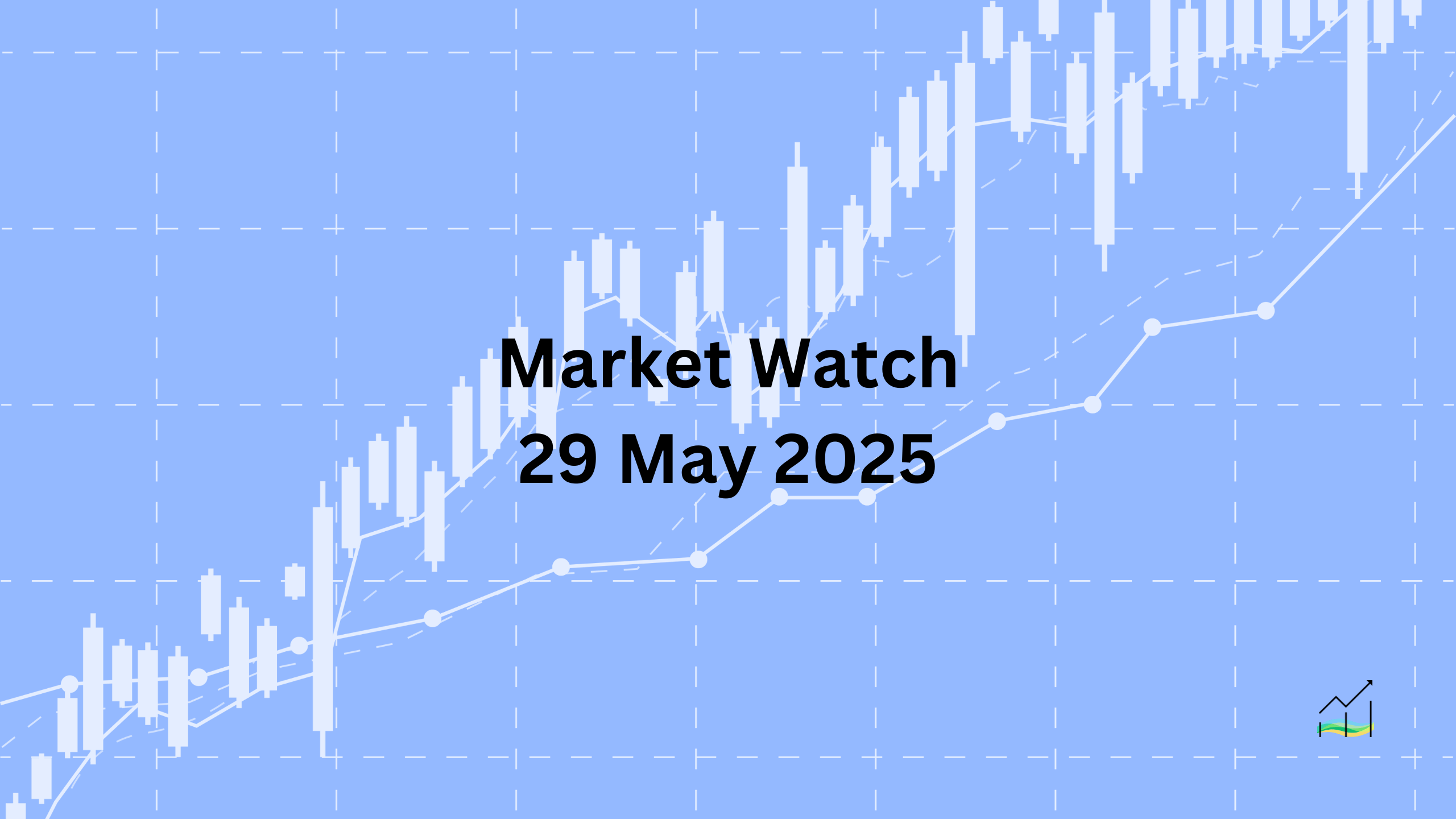29/05/2025 Market Watch

Market Rebounds as U.S. Tariff Ruling Fuels Risk Appetite
Key Takeaways:
- US Court rules Trump-era tariffs unjustified, sparking legal uncertainty.
- Dollar shows mixed performance; emerging markets remain cautious.
- Global equities react positively; US futures and Stoxx 600 gain.
- Bond yields diverge; US 10-year up, Japan's 40-year sharply down.
- Gold stabilises after steep drop; WTI crude extends gains.
A key development today came from the US Court of International Trade, which ruled that the Trump administration's "Liberation Day" tariffs were not legally justified. The court found that the 1977 law cited to defend these tariffs did not apply, and the decision also extends to earlier tariff actions targeting border security and fentanyl trafficking. While the White House plans to appeal, markets are already adjusting to the potential legal and political ramifications.
The dollar initially rose but later turned mixed, with commodity-linked currencies and Scandinavian currencies showing renewed strength. Meanwhile, emerging market currencies lagged in their recovery, although the Russian ruble and Chinese yuan are seeing modest gains.
Equity markets broadly welcomed the court's decision, with the European Stoxx 600 recovering more than half of the prior session’s losses and gaining for the third time this week. US futures are also on solid footing, with the S&P 500 and Nasdaq both showing strong pre-market gains.
Fixed income markets are under some pressure. The US 10-year Treasury yield is climbing toward 4.54%, while Japan’s bond market saw a dramatic split—its 30-year yield jumped nearly eight basis points, but the 40-year yield plummeted by 22 basis points. European benchmark yields are slightly higher.
In commodities, gold is attempting to recover after a sharp drop from $3287 to $3245. It remains relatively flat in late European trading. Crude oil prices are stronger, with July WTI rising above $63 before settling near $62.50, still well above last week’s close.
United States of America
Overview
The US dollar initially spiked following the Court of International Trade’s ruling that invalidated the Trump-era "Liberation Day" tariffs, but the gains were short-lived. The Dollar Index opened near 100.50, briefly marking its high, and has since retreated toward 99.95, reflecting a softening sentiment. Market focus has shifted from backward-looking data such as Q1 GDP revisions to more current indicators, with the Atlanta Fed forecasting Q2 growth at 2.2%. In contrast, Bloomberg’s survey of Wall Street economists suggests a weaker 1.3% pace.
Container shipments from China had shown signs of recovery earlier in the quarter, driven by expectations of eased trade friction following talks in Switzerland. However, volumes have declined again, hinting at continued uncertainty in global trade flows. Domestically, weak payroll withholding tax data and unseasonably low fuel demand point to underlying softness in US consumption. The labor market, while still tight, is losing momentum, as indicated by subdued jobless claims and a slower hiring pace. Early forecasts for May’s nonfarm payrolls point to a notable slowdown.
Economic Drivers
- Court ruling against Trump-era tariffs unsettled trade policy outlook.
- Q2 GDP growth projected at 2.2% by the Atlanta Fed; Bloomberg consensus is 1.3%.
- Container shipments from China fell after temporary improvement.
- Weaker payroll tax collections hint at sluggish income growth.
- Fuel consumption across gasoline, distillates, and jet fuel remains below seasonal norms.
- Labor market softening, with slower hiring and elevated revisions to prior payroll data.
Data and Events
- 29 May 2025: FOMC Meeting Minutes.
- 29 May 2025: Prelim GDP.
- 29 May 2025: Unemployment Claims.
- 29 May 2025: Pending Home Sales.
Price Action
- Dollar Index gapped higher at open, peaked near 100.50, and is drifting lower toward 99.95.
- Short-term support may emerge near the prior session’s high.
- Market appears cautious ahead of next week’s nonfarm payroll report.
Key Points:
- Dollar gave up early gains after court ruling on tariffs.
- Q2 economic growth forecasts remain divided.
- Trade and fuel data suggest softening demand.
- Labor market momentum is waning.
- Price action shows dollar hesitating near resistance.
Australia
Overview
The Australian dollar began the week on a strong footing, reaching its highest level this year just above $0.6535, narrowly missing the $0.6550 mark. However, the currency was unable to maintain that strength, closing slightly lower on Monday and extending its losses over the following two days to a low of $0.6410. This marks a three-day decline, equalling the longest losing streak since March. Early Thursday trading saw a marginal new low just above $0.6405 before rebounding to $0.6440, suggesting some stabilisation may be taking place.
Australia’s economic calendar is relatively light until the release of Q1 GDP on June 4. In the meantime, market sentiment is being shaped by weaker-than-expected private capital expenditure data, which fell by 0.1% in Q1, down from a 0.2% increase in the final quarter of 2024. These results slightly dampen expectations for broader economic strength. Upcoming data on April retail sales and private sector credit are likely to provide additional clarity.
Economic Drivers
- Private capital expenditure declined 0.1% in Q1, a disappointment compared to the previous quarter.
- Broader market focus is shifting toward Q1 GDP due on 4 June.
- Market expectations for April retail sales and private credit growth remain steady.
Data and Events
No major economic releases are scheduled today.
Price Action
- AUD/USD peaked just above $0.6535 before reversing lower.
- Three consecutive days of decline matched the longest streak since March.
- Thursday’s rebound to $0.6440 may signal potential bottoming near $0.6405.
Key Points:
- Australian dollar lost momentum after yearly high.
- Weak Q1 capital expenditure adds to economic concerns.
- Attention turns to upcoming retail and credit data.
- Price action shows tentative recovery after sharp drop.
Canada
Overview
The Canadian dollar came under renewed pressure this week, with the US dollar rebounding sharply after hitting a seven-month low near CAD1.3685 on Monday. This reversal was marked by a bullish hammer candlestick formation, followed by continued gains that pushed the greenback to CAD1.3945 by Wednesday. This level represents a 50% retracement of the prior decline from the May 15 high, when the US dollar last traded above CAD1.40. In early Thursday trade, a brief spike brought the pair close to CAD1.3865 before retreating to the CAD1.3820 area. Resistance near CAD1.3875–85 remains key, housing both the 20-day moving average and the 61.8% retracement level.
On the macroeconomic front, Canada released its Q1 current account data, showing a widening deficit. Although this report rarely moves markets in a meaningful way, it adds incremental insight into the country’s external balance. The Q1 2025 deficit came in around C$3.24 billion, higher than the C$2.23 billion recorded in Q1 2024. Despite this increase, Canada’s external position remains relatively stable compared to pre-pandemic norms, with the 2024 full-year deficit representing just 0.5% of GDP—a notable improvement from the 2.0% to 3.5% of GDP range seen in the decade leading up to the pandemic.
Economic Drivers
- US dollar rebounded strongly against the Canadian dollar after reaching a multi-month low.
- Canada’s current account deficit widened in Q1 2025 to C$3.24 billion, from C$2.23 billion in Q1 2024.
- Long-term structural improvements in Canada’s trade position since COVID continue to hold.
- Full-year 2024 deficit amounted to just 0.5% of GDP, significantly below pre-pandemic norms.
Data and Events
No major economic releases are scheduled today.
Price Action
- USD/CAD formed a bullish hammer after bottoming near CAD1.3685.
- Rally extended to CAD1.3945, retracing 50% of the decline from the May 15 high.
- Brief intraday spike to CAD1.3865 followed by pullback to CAD1.3820.
- Key resistance at CAD1.3875–85 includes the 20-day moving average and 61.8% retracement.
Key Points:
- Canadian dollar weakens after USD rebound from multi-month low.
- Current account deficit widened but remains low by historical standards.
- Market attention remains focused on technical retracement levels.
- Structural trade balance improvements continue post-COVID.
Europe
Overview
The euro began the week strongly, reaching a high near $1.1420 on Monday, but has since weakened, touching a nine-day low at $1.1210 earlier today. The decline followed the first consecutive daily losses in three weeks, signalling some exhaustion in recent upward momentum. However, by the European session, the currency had regained some ground, trading back near $1.1280. A daily close above $1.1300 would suggest a shift toward a more constructive short-term outlook.
In terms of broader context, news flow out of the Eurozone has been relatively light. Attention is focused on the ramping up of US-EU trade negotiations, which are set to become more active beginning today. EU Trade Commissioner Maroš Šefčovič is expected to be in regular communication with the US delegation, led by Commerce Secretary Lutnick and Trade Representative Greer. The increased pace of talks suggests that both sides are aiming for substantial progress in the coming weeks.
Economic Drivers
- The euro weakened after a strong start to the week, driven by fading momentum and lighter news flow.
- Focus shifts to US-EU trade talks, which have now entered an intensive negotiation phase.
- EU Trade Commissioner Šefčovič will maintain near-daily contact with the US team.
Data and Events
No major economic releases are scheduled today.
Price Action
- Euro declined from $1.1420 to a nine-day low at $1.1210.
- Recovered toward $1.1280 in European trading.
- A close above $1.1300 could improve the technical bias.
Key Points:
- Euro fell to a nine-day low after recent strength faded.
- Recovery underway, but resistance seen near $1.1300.
- US-EU trade negotiations now in focus.
- News flow from the Eurozone remains limited for now.
Japan
Overview
The Japanese yen has come under pressure as the US dollar recorded a potential key reversal pattern earlier this week. On Tuesday, the greenback traded on both sides of Monday’s range before closing above its high, setting the stage for follow-through gains. It climbed past JPY145.00 on Wednesday and briefly touched JPY146.30 today before pulling back to find support just above the JPY145.00 mark in European trading. The reversal and follow-up strength suggest renewed interest in the dollar against the yen, with market participants watching for technical confirmation ahead of key economic data.
Japan’s weekly Ministry of Finance portfolio flow report offers a glimpse into investor behaviour. Japanese investors have maintained a steady pace of foreign bond purchases, averaging JPY215 billion per week, slightly below last year’s JPY220 billion. However, the real shift is in equities: Japanese investors have turned from net sellers to net buyers of foreign stocks, averaging JPY355 billion weekly versus net selling of JPY44 billion a year ago. Meanwhile, foreign interest in Japanese bonds has grown considerably, with average purchases surging to JPY455 billion a week from just JPY14.6 billion last year. Foreign interest in Japanese stocks has declined sharply year-on-year.
Looking ahead, Japan faces a significant data release tomorrow covering employment, industrial production, retail sales, and Tokyo's CPI. Tokyo's May inflation is expected to remain firm, with headline and core figures forecast between 3.4% and 3.5%. Industrial output likely contracted in April, reflecting weaker business activity amid the impact of US tariffs. Retail sales, however, are expected to rebound following a sharp 1.2% decline in March.
Economic Drivers
- US dollar gains after potential reversal pattern and follow-through buying.
- Japanese investors continue steady purchases of foreign bonds and have shifted to buying foreign equities.
- Foreigners increased purchases of Japanese bonds but significantly reduced buying of Japanese equities.
- Portfolio flow data may not fully reflect true origin due to offshore booking practices.
- Anticipation of Tokyo CPI and broader macro data points tomorrow.
Data and Events
- 29 May 2025: Consumer Confidence.
Price Action
- USD/JPY confirmed potential reversal by closing above prior high and extending gains.
- Reached intraday high near JPY146.30 before pulling back toward JPY145.00.
- Support holding above JPY145.00 suggests consolidation before data releases.
Key Points:
- Yen weakens as USD/JPY confirms bullish reversal and retests key resistance.
- Japanese and foreign portfolio flows show significant year-on-year shifts.
- Tokyo CPI, jobs, and retail data likely to set the near-term tone.
- Price action stabilising ahead of major economic releases.
© 2025 SKONE Enterprise (003319453-V). All rights reserved.
The content on this site is for informational purposes only and does not constitute financial advice.


